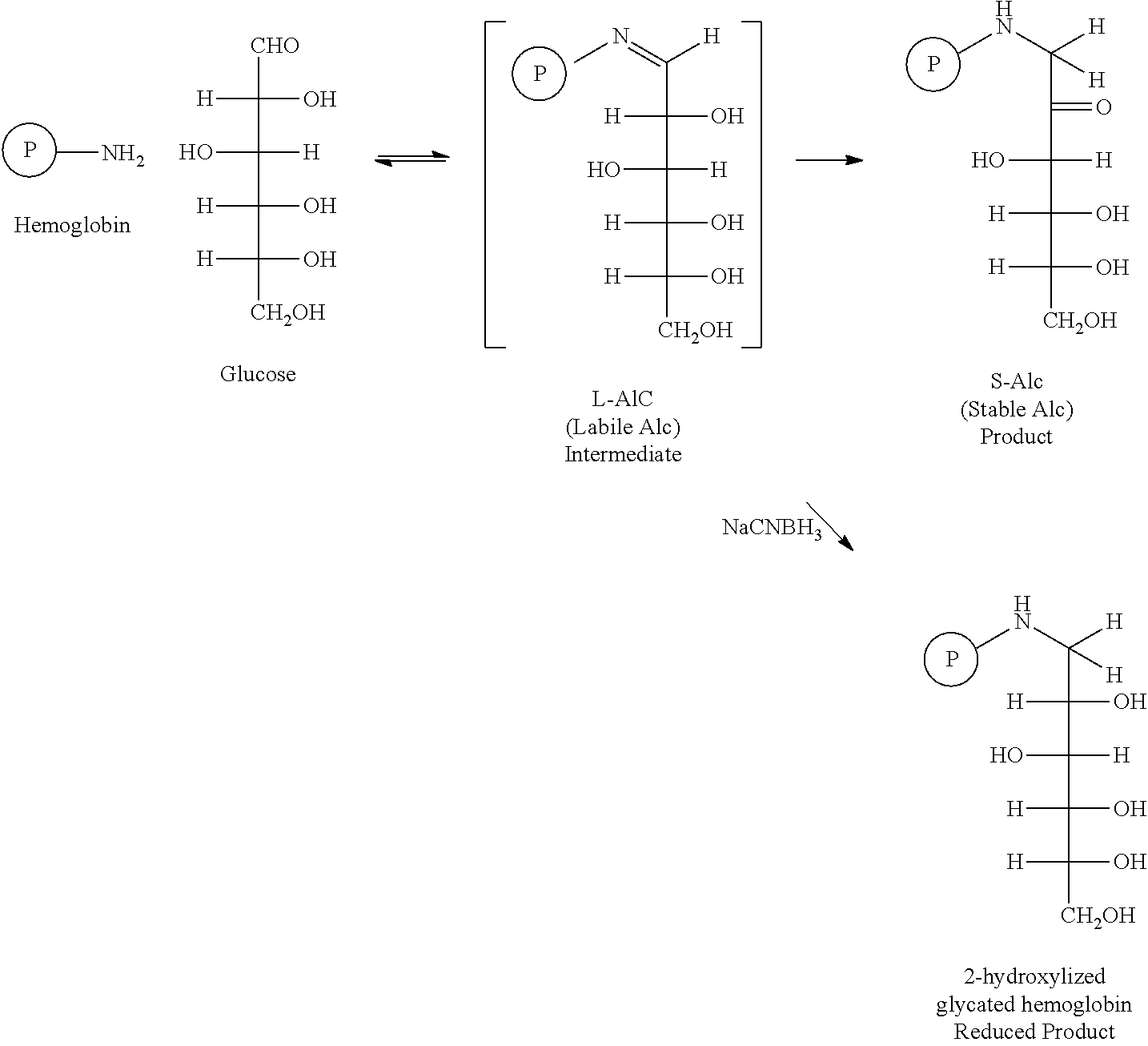Method of preparing controls for glycated hemoglobin s-a1c derived from healthy blood cells
a technology of glycated hemoglobin and healthy blood cells, which is applied in the field of preparing controls for glycated hemoglobin sa1c derived from healthy blood cells, can solve the problems of insufficient quantity of diabetic blood samples, inability to use diabetic blood samples for control, and inability to meet the needs of patients,
- Summary
- Abstract
- Description
- Claims
- Application Information
AI Technical Summary
Benefits of technology
Problems solved by technology
Method used
Image
Examples
examples 1 to 5
[0048]Red blood cells are processed as described above with at ambient temperature (about 22° C.) for 7 days. The S-Alc glycated hemoglobin concentrations are measured prior to glycation and after glycation by Tosoh Alc 2.2 Plus (HPLC) and Tosoh G8 analyzer. The results are compiled in Table 5.
TABLE 56% mannoseGlycationInitial S-AlcFinal S-AlcExTemp. / Time(%)(%)1RT / 7 days6.110.52RT / 7 daysx10.43RT / 7 days6.210.54RT / 7 days5.910.55RT / 7 days5.911.0
RT means room temperature which is about 22° C. Table 5 illustrates the increase in S-Alc by glycating red blood cells with mannose at room temperature for 7 days.
examples 6 to 10
[0049]Red blood cells are glycated as described above using mannose at room temperature for 7 days. Deglycation is performed for 24 hours at room temperature. The S-Alc and L-Alc hemoglobin concentrations are measured by HPLC methods at several points in the process. The results are compiled in Table 6.
TABLE 6A1c concentrations at different stages of glycation with mannoseA1cPre-Post-Post-washing / Post-Post-fix / Experiment(%)glycationglycationPre-deglycationdeglycationfinal6L-A1c10.27.04.74.05.5S-A1c6.210.911.612.311.47L-A1c8.56.05.13.94.8S-A1c6.110.111.311.611.08L-A1c6.55.64.14.55.7S-A1c6.211.812.012.512.09L-A1c6.36.6Deglycation4.05.5S-A1c6.210.9skipped10.910.710L-A1c7.06.04.24.6S-A1c6.09.09.09.3
[0050]Table 6 illustrates that samples glycated with mannose are not required to deglycate at 30° C. for 24 in order to lower the elevated L-Alc concentration. Table 6 shows that the L-Alc concentration is decreased during removal of the glycating agents by washing the cells into the washing ...
examples 11 to 13
[0051]Red blood cells are processed and tested as described in Examples 6 to 10. The results are compiled in Table 7.
TABLE 7A1c conc. at different stages of glycation with mannoseA1cPre-Post-Post-washing / Post-Post-fix / Examples(%)glycationglycationPre-deglycationdeglycationfinal11L-A1c20.511.04.93.95.2S-A1c010.410.711.111.112L-A1c21.511.56.15.04.4S-A1c010.510.811.511.913L-A1c7.9004.96.5S-A1c5.911.011.210.711.1
[0052]Table 7 illustrates the advantages of the deglycation step. The first benefit of deglycation is that the L-Alc concentration is further decreased by 1% as well as S-A concentration is slightly increased (˜0.5%) during the deglycation. The second advantage is very specific for Tosoh G8 instrument and related to process development rather than product quality. The hemoglobin composition determined by Tosoh G8 analyzer shows absence of L-Alc Such abnormality in hemoglobin composition is not observed once the samples are deglycated at room temperature for 24 hours.
PUM
| Property | Measurement | Unit |
|---|---|---|
| temperature | aaaaa | aaaaa |
| temperature | aaaaa | aaaaa |
| temperature | aaaaa | aaaaa |
Abstract
Description
Claims
Application Information
 Login to View More
Login to View More - R&D
- Intellectual Property
- Life Sciences
- Materials
- Tech Scout
- Unparalleled Data Quality
- Higher Quality Content
- 60% Fewer Hallucinations
Browse by: Latest US Patents, China's latest patents, Technical Efficacy Thesaurus, Application Domain, Technology Topic, Popular Technical Reports.
© 2025 PatSnap. All rights reserved.Legal|Privacy policy|Modern Slavery Act Transparency Statement|Sitemap|About US| Contact US: help@patsnap.com


